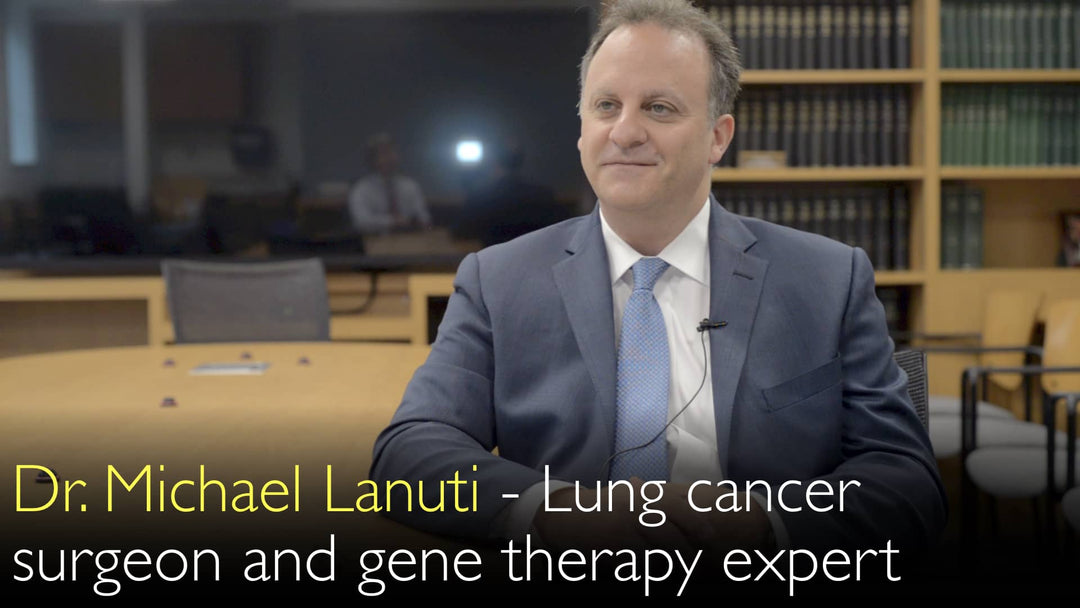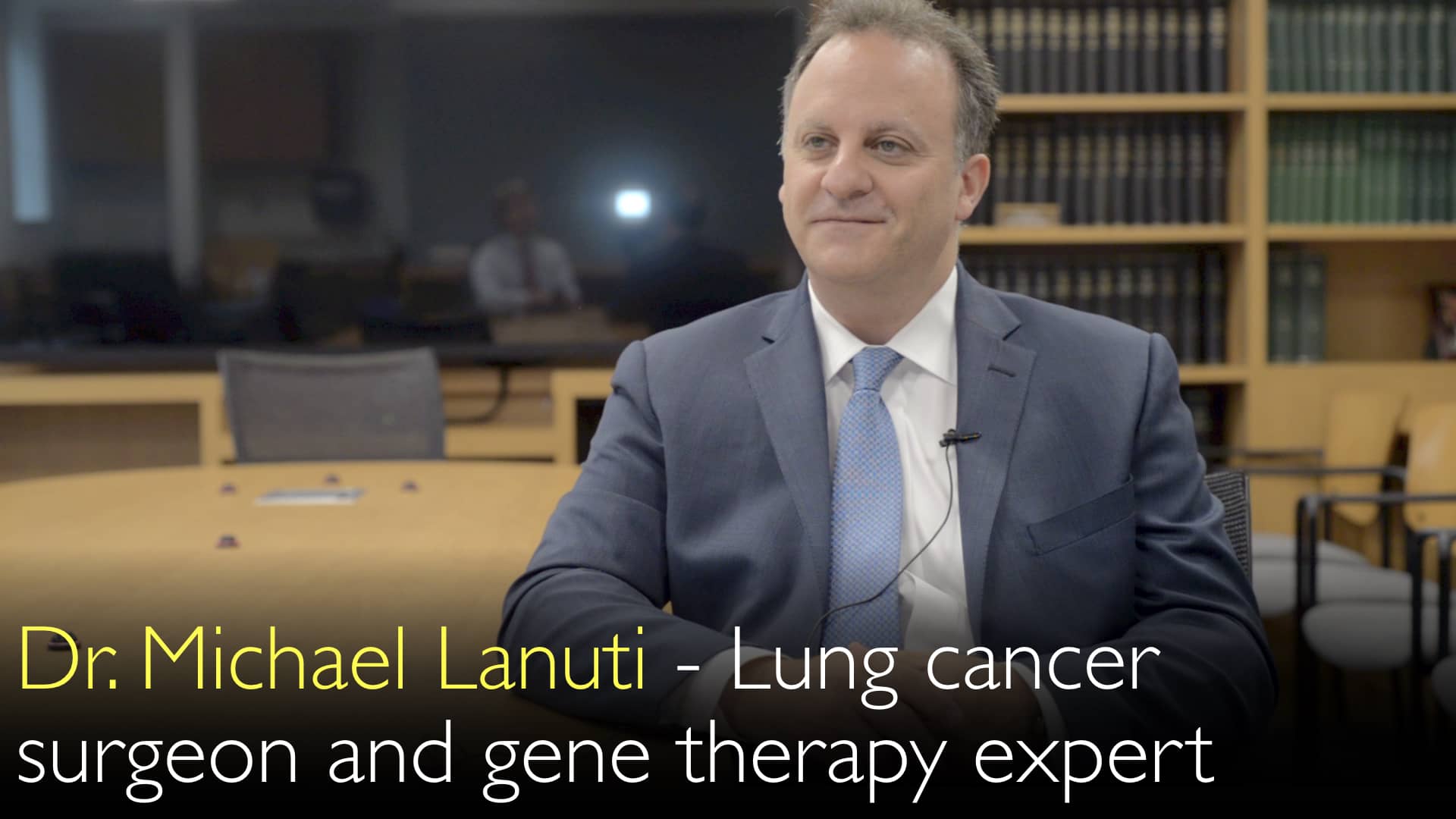Leading expert in thoracic surgery and cancer gene therapy, Dr. Michael Lanuti, MD, explains the critical importance of lung cancer staging, detailing the advanced diagnostic tools like navigation bronchoscopy and endobronchial ultrasound that guide personalized treatment plans for patients.
Advanced Lung Cancer Staging and Diagnostic Techniques
Jump To Section
- Importance of Accurate Lung Cancer Staging
- Initial Diagnostic Approach for Lung Cancer
- Navigation Bronchoscopy for Lung Nodules
- Endobronchial Ultrasound for Lymph Node Staging
- Integrating Staging Data for Treatment Decisions
- Minimally Invasive Surgery in Lung Cancer
- The Future of Lung Cancer Diagnosis and Treatment
Importance of Accurate Lung Cancer Staging
Lung cancer treatment options are entirely dependent on the correct staging of the tumor. Dr. Michael Lanuti, MD, emphasizes that this is the most critical step after a patient receives a lung cancer diagnosis or even a strong suspicion of the disease. Staging determines the extent of the cancer's spread, which directly dictates the appropriate therapeutic pathway, whether it involves surgery, chemotherapy, radiation, or a combination of these modalities.
An accurate stage provides a prognosis and ensures patients receive neither overtreatment nor undertreatment. Dr. Michael Lanuti, MD, explains that modern staging is a multidisciplinary process, integrating findings from imaging, minimally invasive biopsies, and molecular profiling to create a complete picture of the disease.
Initial Diagnostic Approach for Lung Cancer
The diagnostic journey often begins when a patient presents with symptoms or, increasingly, a small lung nodule is discovered incidentally on a CT scan. Dr. Michael Lanuti, MD, notes that the initial step involves a thorough review of this imaging. The size, location, and characteristics of the nodule—such as spiculation or ground-glass opacity—help stratify the risk of malignancy.
For suspicious lesions, the next step is to obtain a tissue diagnosis. Dr. Michael Lanuti, MD, states that the approach is tailored to the nodule's location. Peripheral nodules might be biopsied via a CT-guided needle, while central lesions or those near airways are ideal candidates for advanced bronchoscopic techniques, which he specializes in at Massachusetts General Hospital.
Navigation Bronchoscopy for Lung Nodules
Navigation bronchoscopy represents a revolutionary tool for diagnosing difficult-to-reach lung nodules. Dr. Michael Lanuti, MD, describes it as a GPS-like system for the lungs. The technology allows a physician to create a 3D virtual roadmap of the patient's airways from a CT scan.
During the procedure, a thin, flexible bronchoscope is navigated through the intricate bronchial tree to the precise location of the nodule. Once there, tools can be extended through the scope to take biopsies. This minimally invasive technique has dramatically improved the diagnostic yield for small peripheral nodules that were previously only accessible with more invasive surgical biopsy.
Endobronchial Ultrasound for Lymph Node Staging
Endobronchial ultrasound, or EBUS, is a cornerstone procedure for accurate lung cancer staging. Dr. Michael Lanuti, MD, highlights its critical role in assessing the mediastinal and hilar lymph nodes. Cancer spread to these lymph nodes significantly changes the stage and treatment plan.
During an EBUS procedure, a bronchoscope with an ultrasound probe at its tip is passed into the airways. The ultrasound allows Dr. Lanuti to visualize lymph nodes adjacent to the windpipe and major airways in real-time. A needle can then be passed through the scope to safely biopsy these nodes. This outpatient procedure provides crucial staging information without the need for more invasive surgery.
Integrating Staging Data for Treatment Decisions
Once all biopsies and imaging are complete, the multidisciplinary team integrates the data to assign a final clinical stage. Dr. Michael Lanuti, MD, explains that this stage combines the size and extent of the primary tumor (T), the status of the lymph nodes (N), and the presence or absence of distant metastasis (M)—the TNM system.
This integrated staging dictates the treatment strategy. For example, early-stage disease (Stages I and II) is typically treated with curative-intent surgery. Locally advanced disease (Stage III) often requires a combination of chemotherapy, radiation, and sometimes surgery. Stage IV disease, where cancer has spread to other organs, focuses on systemic therapies like chemotherapy, targeted therapy, or immunotherapy.
Minimally Invasive Surgery in Lung Cancer
For patients who are candidates for surgery, minimally invasive techniques have become the standard of care. Dr. Michael Lanuti, MD, is a specialist in Video-Assisted Thoracoscopic Surgery (VATS). This approach involves making several small incisions and using a camera and specialized instruments to remove the lobe of the lung containing the cancer.
As Dr. Anton Titov, MD, noted, Dr. Lanuti's expertise allows for complex procedures through incisions as small as 5 cm. Compared to traditional open surgery, VATS results in less pain, a shorter hospital stay, a faster recovery, and equivalent cancer outcomes. This focus on minimizing patient trauma is a hallmark of modern thoracic surgical oncology.
The Future of Lung Cancer Diagnosis and Treatment
The future of lung cancer care is moving towards even greater personalization. Dr. Michael Lanuti, MD, whose research background is in cancer gene therapy, points to the growing importance of molecular profiling. Biopsied tissue is now routinely tested for genetic mutations and biomarkers.
This molecular staging allows for the use of targeted therapies that attack specific cancer cell mutations and immunotherapies that boost the body's own immune system to fight cancer. Dr. Lanuti concludes that the integration of advanced diagnostics, minimally invasive techniques, and personalized systemic therapy is steadily improving survival and quality of life for lung cancer patients.
Full Transcript
Dr. Anton Titov, MD: Dr. Michael Lanuti, MD, has superior skills in minimally invasive lung cancer and esophageal cancer surgical treatment. He combines clinical expertise with top-notch research in cancer gene therapy. He cured my mother from a lung tumor via a 5 cm incision.
Hello from Boston! We are with Dr. Michael Lanuti, MD. He is Associate Professor of Surgery at Harvard Medical School and Director of Thoracic Oncology for the Division of Thoracic Surgery at Massachusetts General Hospital in Boston.
Dr. Lanuti obtained his MD from the University of Pennsylvania School of Medicine. He completed a residency in surgery at the Hospital of the University of Pennsylvania and a research fellowship in a thoracic oncology laboratory, focusing on gene therapy for lung cancer.
He then finished a Cardiothoracic Fellowship at Massachusetts General Hospital in Boston.
Dr. Michael Lanuti's clinical interests are in lung cancer diagnosis and treatment, lung cancer molecular screening and gene therapy, minimally invasive lung cancer surgery, video-assisted thoracoscopic surgery, navigation bronchoscopy of lung nodules, endobronchial ultrasound for lung cancer staging, and radiofrequency ablation for lung tumors.
Dr. Lanuti is also interested in the diagnosis and treatment of esophageal cancer, Barrett's esophagus, mediastinal tumors, germ cell tumors, and the surgical treatment of myasthenia gravis.
Dr. Michael Lanuti, MD, authored and co-authored 110 publications in peer-reviewed international medical journals and presented at numerous international medical conferences. He wrote several book chapters on lung cancer diagnosis and treatment.
Dr. Anton Titov, MD: Dr. Lanuti, hello and welcome!
Dr. Michael Lanuti, MD: Thank you!
Lung cancer treatment options depend on correct staging of the tumor. It is a very important step after a patient is diagnosed with or suspected to have lung cancer.
Dr. Anton Titov, MD: How do you stage patients with lung cancer?





